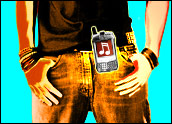
The adolescent crowd is especially enamored with two items: music and cell phones. Naturally, therefore, handset manufacturers and carriers have begun to find ways to integrate the two. A few devices that integrate static music selections or FM radio signals into cell phones have already started to make their way from research and development laboratories to store shelves, and a slew of others are expected to follow.
“Many users carry a cell phone and a musical device like an MP3 player or an iPod, so the question becomes: Why carry two when one will do?” said Bob Egan, president of consulting firm Mobile Competency Inc.
Convenience Factor
Nokia Group and Motorola Inc. are at the head of pack in delivering such devices. Nokia has three handsets, the Nokia 7710, Nokia 3230 and Nokia 6230i, that are designed to marry music and cell phones. Motorola has not yet formally announced its iRadio or its iTunes-compatible handsets, but has broadly outlined the phones’ features and functions.
These companies are trying to take advantage of the widespread popularity of portable music players, such as Apple’s iPod digital music player, and the growing demand for commercial-free satellite radio services, such as Sirius Satellite Radio Inc. and XM Satellite Radio Inc.
The vendors’ new handsets are designed to work with cellular services and enable users to listen to their favorite musical genres, artists, and tunes wherever they may be.
What’s the attraction with devices like these? Convenience, for one. Individuals will be able to listen to their favorite tunes or morning radio shows while in a car, the yard, or jogging on the road or treadmill. For music producers and radio stations, the new services broaden their distribution channels and offer them one more way to reach potential customers.
Small but Powerful
Before the services become common, a number of items have to be addressed, starting with the design of the handsets. In general, these cellular devices have been improving, so they are better able to support audio transmissions. However, while most handsets include at least rudimentary audio functions, the new services demand the integration of sophisticated features, such as stereo speakers. In addition, vendors may need to boost the memory available in the devices so they can store adequate audio content.
Another challenge is suppliers have to compress the different functions into a small form factor but also make sure the devices have sufficient battery power to work for at least a few hours. The handhelds also need to be able to effectively dissipate any heat generated. “A few years ago, limitations with handset design would have prevented vendors from integrating cell phones and music players, but cell phones have evolved so it is possible for them to support high quality audio transmissions,” said Neil Strother, an industry analyst with In-Stat/MDR Inc.
Handset pricing may present a more daunting challenge. The market is nascent, and vendors are under pressure to recoup part of their substantial investments in research and development. As a result, the new products, which include a few hundred megabytes of Random Access Memory, come with high prices, in the US$200 to $600 range. In addition, users may have to pay extra for items, such as Bluetooth support, a low-range wireless technology that streams content from the phone to the car radio or home stereo, or wireless audio adapters.
Carrier networks need sufficient bandwidth so users can quickly and easily download audio clips. “Many vendors have been moving to 3G networks, which are designed to support multimedia services and therefore should be able to deliver high quality audio transmissions,” said Alan Varghese, a principal analyst at market research firm ABI Research Inc.
Moving Music from Here to There
The most significant challenges may stem from figuring out how music will travel from source to destination. “Vendors are developing a new market, so a number of business models are being tested and which one will prove to be most popular is unclear at the moment,” In-Stat/MDR’s Strother told TechNewsWorld. In fact, a couple of different distribution options have emerged.
The simplest one mimics the various music downloading services, where users connect to a Web site, select the music that interests them, download it, and then play it back on a handheld device. In this scenario, the big question is what the carrier’s role in music distribution is. One possibility is having the carrier take on tasks such as customer service and billing.
A second variation starts with the type of music distributed. Current music services distribute static content, such as songs from an album; the new services are also being built to work with dynamic content, such as a morning radio show. SBS Finland’s Kiss FM and Virgin Radio in England have begun pilots to download live content to users’ handsets and Clear Channel Communications Inc. plans to offer similar services in the U.S. by the end of 2005. In these cases, a handset has to include something like Global Positioning System, which tracks a user’s location, so content can be delivered to the customer dynamically.
Once the various players determine how to distribute their services, the issue of service pricing arises. Monthly subscription rates have been a popular model and Motorola has hinted that it will follow this model with its service. iRadio customers are expected to be able to download 10 hours of content during one interval, at a cost of about $5 to $7 per month.
As the new products and services become available during the year, it will become clearer whether handset vendors and cellular network providers have produced a Top 40 hit or a bust.




















































